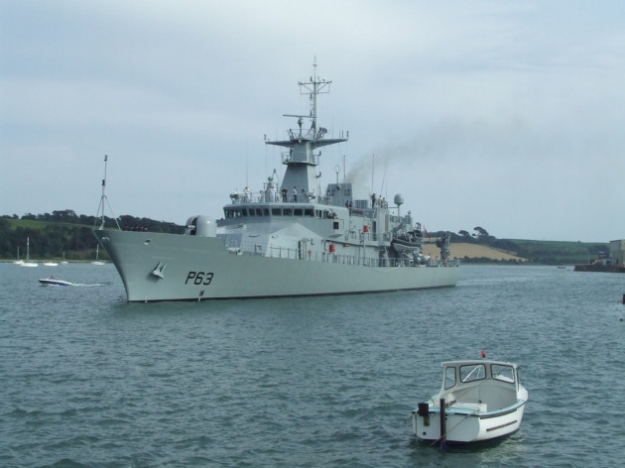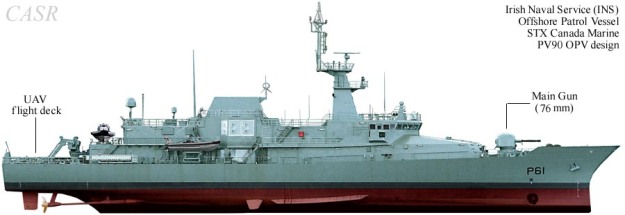Babcock Marine’s Samuel Beckett Class offshore patrol vessels (OPVs) are being built for the Irish Naval Service as a part of a fleet replacement programme. The OPVs will be primarily deployed in fishery protection, search-and-rescue (SAR) and maritime patrol missions across the 200-mile Irish Economic Exclusion Zone (EEZ) in the North Atlantic Ocean.
The Department of Defence (An Roinn Cosanta) signed a contract with Babcock Marine in October 2010, for the construction of two new OPVs for the Irish Naval Service at an estimated cost of €108m. The contract also includes an option for third vessel, which was exercised in June 2014.
The keel for the first OPV, LÉ Samuel Beckett (P61) was laid down at Babcock’s Appledore shipyard in May 2012. The vessel was floated out of the drydock in November 2013, arrived at the Naval Base, Haulbowline in April 2014 and was commissioned into service in May 2014. LÉ Samuel Beckett replaced the decommissioned offshore patrol vessel LÉ Emer.

LÉ Samuel Beckett (P61)
The second OPV in class, LÉ James Joyce (P62), was floated out in November 2014 and was commissioned in September 2015. It replaced LÉ Aoife OPV.

LÉ William Butler Yeats (P63) – Image @coastmonkey.ie

LÉ William Butler Yeats (P63) – Image @coastmonkey.ie
The third OPV in class, LÉ William Butler Yeats (P63), was floated out in March 2016. It is scheduled to be delivered by the end of 2016. LÉ William Butler Yeats will replace the LE Aisling OPV.
PICTURES: Naval ship handed over as work begins on next project: Here

(P63) LE William Butler Yeats sets sail. Pictures by Norman Hardaker @northdevongazette.co.uk
Samuel Beckett OPV design and features



Images @flickrhivemind.net
The Samuel Beckett OPV features an extended monohull design based on the PV80 design of STX Canada Marine. The OPVs incorporate fin stabilisers and anti-heel tanks for roll and pitch reduction.

Vard Marine Inc. (formerly STX Marine) designed the vessels, which have features in common with an earlier design, the Róisín class, in service with the Irish Naval Service since 1999.
The 90-metre (300 ft) OPV vessels are designated PV90 by Babock Marine and approximately 10 metres (33 ft) longer with an additional 0.6 metres (2 ft 0 in) in depth to the existing Róisín-class PV80 vessels. This is intended to increase both its capabilities and abilities in the rough waters of the North Atlantic. The PV90 ship is designed carry a crew of 44 and have space for up to 10 trainees. The ships’ published cruising speed is 16 knots (30 km/h; 18 mph), with a top speed of 23 knots (43 km/h; 26 mph). Source @wikipedia.org
The vessel can carry two 8m rigid hull inflatable boats (RHIBs) at either side of the hull, while the third RHIB is housed in a cradle over the stern deck. The boats are launched and recovered by single point davits and can be operated at a maximum speed of 30kt up to Sea State 4.
The OPV has a length of 89.5m, beam of 14m, draft of 3.8m and displacement of 1,900t. It can complement of 54 personnel, including 44 Ships Company and ten trainees and the carriage of containers. Accommodation is provided in single berths and four berth cabins.
Weapon systems fitted to the Irish OPV
The main gun of the vessel is a 76mm OTO Melara compact naval gun equipped with an electro-optical fire control system. Two 20mm RH 202 Rheinmetall cannons fitted port and starboard abaft the bridge serve as secondary weapons.
76mm OTO Melara compact naval gun

LÉ Samuel Beckett at The Samuel Beckett Bridge, Dublin.
Technical data:
Caliber: 3 inches / 76,2 mm
Barrel lenght: 186 inches / 4,72 meters (= 62 caliber)
Weight: 7900kg, empty (Super Rapid)
Shell: 76 x 900 mm / 12,34 kilograms
Elevation: – 15° to + 85°
Traverse: 360°
Rate of fire: Compact: 85 rpm / Super Rapid: selectable from single shot up to 120 rpm
Muzzle Velocity: 925 m/s (1100 m/s – DART)
Magazine: Compact: 80 rounds / SR: 85 rounds
Range:
16 kilometers with standard ammunition
20 km with extended range ammunition
up to 40 km with VULCANO ammunition
Source @seaforces.org
SEA EAGLE controls the main Oto Melara Gun
FEATURES
- 24 hour target identification
- Automatic slewing to search radar contact indications
- Automatic target acquisition and tracking
- Anti-air, anti-surface, naval gunfire support and indirect engagement modes
- 24 hour passive surveillance
- Automated capture of target ‘snap-shot’ images
- Designed as a stand alone system or part of ‘multi-function’ console based combat system
Source @chess-dynamics.com
SEA EAGLE controls the main Oto Melara, now Leonardo-Finmeccanica, 76mm gun mounting and is optimised for naval fire control against airborne, surface or shore-based targets. It is capable of controlling all in-service naval guns, using a long range thermal imager and daylight TV camera to provide 24 hour automatic target detection, acquisition, identification and tracking. It uses a mid-wave (3-5µ) thermal imager with zoom optics, a colour TV camera which also has zoom optics and an eye-safe, high repetition rate laser range finder and has been designed to operate through a dedicated standalone console or as a fully integrated element of a multi-function console based combat system. It can be fully integrated with the ship’s radar displays, so that it can slew to search radar contact indications.
As well as the Irish Naval Service, SEA EAGLE is in service with the British, Thai, Omani, and Iraqi Navies and is on order for the Royal Malaysian Navy. Source @miltechmag.com
2 x 20mm RH 202 Rheinmetall cannons

Rheinmetall RH 202 20mm canon – Image @deviantart.com
Gun Characteristics
| Designation | Gun: 20 mm/65 (0.8″) MK 20 DM 5 |
| Ship Class Used On | Present-day German warships |
| Date Of Design | 1962 (1973 Naval Version) |
| Date In Service | 1974 (Naval Version) |
| Gun Weight | 167.5 lbs. (76 kg) |
| Gun Length oa | 120.9 in (3.070 m) |
| Bore Length | N/A |
| Rifling Length | N/A |
| Grooves | N/A |
| Lands | N/A |
| Twist | N/A |
| Chamber Volume | N/A |
| Rate Of Fire | 1,000 rounds per minute cyclic |
Ammunition
| Type | Fixed |
| Weight of Complete Round | N/A |
| Projectile Types and Weights | HE-T: 0.3 lbs. (0.134 kg)
AP-T: 0.3 lbs. (0.134 kg) APDS-T: 0.3 lbs. (0.134 kg) |
| Bursting Charge | N/A |
| Projectile Length | N/A
Length of Complete Round: 8.4 in (21.3 cm) |
| Propellant Charge | 0.092 lbs. (0.42 kg) |
| Cartridge | 20 x 139 mm NATO |
| Muzzle Velocity | HE-T: 3,440 fps (1,050 mps)
AP-T: 3,600 fps (1,100 mps) APDS-T: 3,770 fps (1,150 mps) |
| Working Pressure | N/A |
| Approximate Barrel Life | N/A |
| Ammunition stowage per gun | Ammunition in 200 round belts |
Range
| Elevation | With 0.3 lbs. (0.134 kg) HE Shell |
| Range @ 45 degrees | 2,200 yards (2,000 m) effective |
Mount / Turret Data
| Designation | Rheinmetall single pintle fork mounting: S 20 and SV 20
Norwegian Single Mounts: KV-Sk/20 |
| Weight | Rheinmetall S 20
Without gun or ammunition: 617 lbs. (280 kg) With gun and 200 rounds ammunition: 948 lbs. (430 kg) Rheinmetall SV 20 N/A Norwegian Without ammunition: 880 lbs. (400 kg) |
| Elevation | Rheinmetall: -10 / +55 (or +60) degrees
Norwegian: -15 / +70 degrees |
| Elevation Rate | Manually operated, only |
| Train | 360 degrees |
| Train Rate | Manually operated, only |
| Gun recoil | N/A |
| Note: The Norwegian version is based upon the FK20-2 field-gun mounting. Norway also uses this gun in their coastal defense units to provide protection to larger guns from land and air attacks. | |
Source @navweaps.com
The vessel is also provided with mountings on the main deck and 01 deck for two 12.7mm heavy machine guns (HMGs), and four 7.62mm general purpose machine guns (GPMGs).
2 x 12.7mm heavy machine guns (HMGs)

Image of HMG is for illustration purpose as no info on actual model
4 x 7.62mm general purpose machine guns (GPMGs)

Image of GPMG is for illustration purpose as no info on actual model
Flight deck

LÉ Samuel Beckett (P61 | by Debs Alanna Simon Alan – Image @flickr.com
The aft flight deck allows for the operations of unmanned aerial vehicles (UAVs) from the vessel. The deck area can also accommodate three 20ft containers and is provided with a large 5t crane at a 9.56m radius.
Propulsion
The diesel electric propulsion integrates two 5,440kW Wartsila medium speed diesel engines driving two five-bladed controllable pitch propellers via reduction gearboxes. The power take in (PTI) motor powered by the electrical alternators ensures low speed operation at speeds up to 8kt.
2 x 5,440kW Wartsila medium speed diesel engine

Wärtsilä 26 engine – Image @nauticexpo.com
Characteristics
Market:
- for ships
Type:
- medium-speed, propulsion
Power source:
- diesel
Technology:
- turbocharged
Cycle:
- 4-stroke
Power:
- 3000-4000 hp
Power:
- Min.: 2040 kW (2735.69 hp)
- Max.: 5440 kW (7295.16 hp)
Source @nauticexpo.com

LÉ William Butler Yeats (P63) – Image @coastmonkey.ie
The offshore patrol vessel also integrates a 450kW bow thruster and rudders for high manoeuvrability in close quarter positions. The dynamic positioning (DP) system aboard the vessels maintains position and heading. The shipboard electricity is generated by three 630kW alternators, while emergency power is provided by a 320kW generator.

Bow thrusters on LÉ William Butler Yeats (P63) – Image @coastmonkey.ie
The propulsion system ensures a maximum speed of 23kt. The vessels have a range of 6,000nmi at a cruising speed of 15kt and are capable of conducting autonomous mission for up to 21 days.
| Type: | Offshore patrol vessel |
| Displacement: | 1,900 tonnes |
| Length: | 90 m (300 ft) |
| Beam: | 14 m (46 ft) |
| Draught: | 3.8 m (12 ft) |
| Propulsion: | Two Wärtsilä medium speed diesel engines (5,440 kW (7,300 hp) each)
450 kW bow thruster |
| Speed: |
|
| Range: | 6,000 nautical miles (11,000 km; 6,900 mi) at 15 knots (28 km/h; 17 mph) |
| Endurance: | 21 days |
| Boats & landing craft carried: |
3 x 8 m (26 ft) RHIB |
| Capacity: | 3 x 6.1 m (20 ft) sea container, 1 x 5 ton, 9.56 m (31.4 ft) crane aft |
| Complement: | 44 + up to 10 trainees |
| Sensors and processing systems: |
Fire control: Electro Optical |
| Armament: |
|
| Aviation facilities: | UAV only |
Table source @wikipedia.org
Main material source @naval-technology.com


